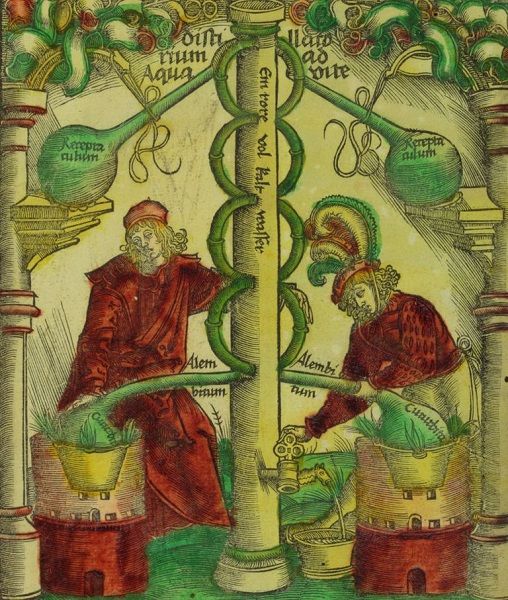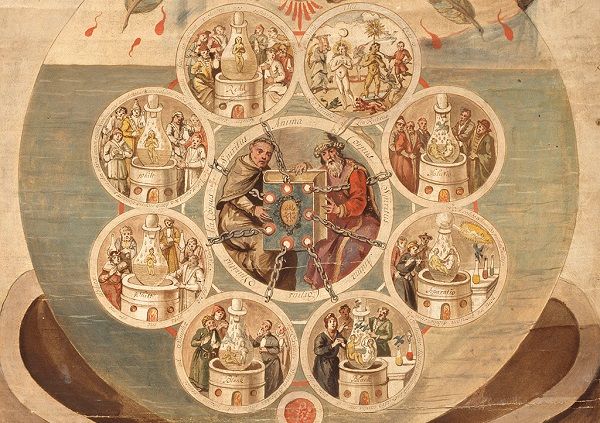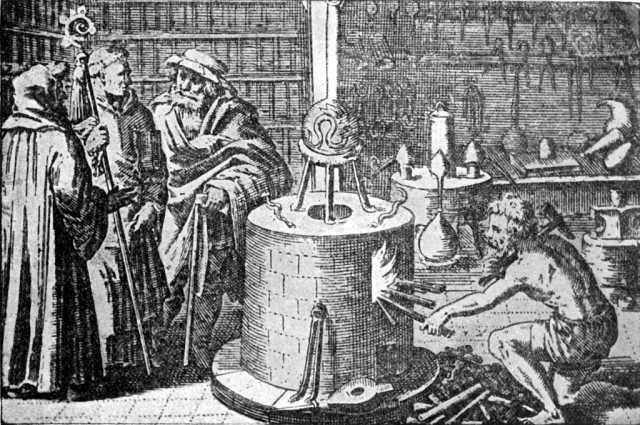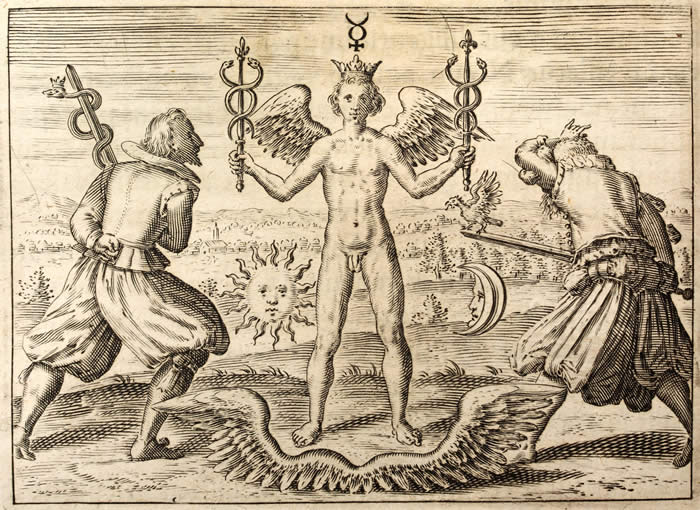What you need to know about alchemy
story·@godflesh·
0.000 HBDWhat you need to know about alchemy
Alchemy is formed around the 4th century and has evolved in the Middle Ages as a peculiar science, the basis of which is the false idea of the possibility of turning the base metals into gold and silver. The origins of these ideas, however, are rooted in ancient times. The transition from the stone age to the metal age for the first time collides with man with gold, silver, and honey. People find the hot metal processing, and they get the first alloy - bronze. And then perhaps the bold dream of metal conversion and the making of gold was born. A dream that Medieval alchemists later so persistently aspire to realize. The language of secret symbols has always concealed alchemy from the curiosity of the uninitiated. And so far we have no clear idea of its true nature: for some people is the making of gold, for others - finding the elixir of immortality, and for third - the transformation of man.  Alchemy is the mother of chemistry. It was in the alchemical laboratories that for the first time sulfuric, nitric and hydrochloric acid, sulphate and gunpowder and many drug substances were obtained. Medieval alchemists had very specific tasks. One of the forefathers of European alchemy, Roger Bacon (XIII century) writes: "Alchemy is a science of how to prepare a composition or a elixir that, if added to base metals, will make them perfect metals." the simple metals in noble, the alchemist throws a challenge of nature itself. Although in medieval Europe alchemy was virtually out of the law, many church and secular figures have patronized it by relying on "scornful metal." Not only they have patronized her, but they have also been involved with her. Alchemy became truly a "royal art". Stuff II (1670-1733), whose claims to the Polish crown required considerable funds, made Dresden a real capital of alchemy. To fill the treasury with gold, he attracted the talented alchemist Johann Friedrich Böhmer. Whether Böhmer has succeeded in the golden run, history is silent. Alchemists in Europe were many, but the Adepts-those who had discovered the mystery of the philosophical stone-were units.  The roots of alchemy lead to hermetism - a teaching interwoven with the traditions of ancient Greek naturophilosophy, Chaldean astrology and Persian magic. Hence the mysterious and pronounced language of alchemy treatises. Alchemical metals are not just substances but a personification of the cosmic order. Thus gold in alchemical manuscripts becomes Sun, silver in Moon, mercury in Mercury, lead in Saturn, tin in Jupiter, iron in Mars, copper in Venus. The choice of the seven celestial bodies is also not accidental. The week is a sign of completeness and perfection, a high degree of craving for knowledge and wisdom, a testimony of magical power, and a guardian of secrets. Mysterious looks also recipe recorded in hermetic treatises. The English alchemist George Ripley (XV century), to prepare the wisdom elixir, proposes to inculcate philosophical mercury until it first turns green and then into a red lion. The liquids that are emerging from it advise to be collected, resulting in "tasteless mucus, alcohol, and red drops." It's getting blurred further. "Kimeric shadows cover the retort with its pale cover. It burns up, and soon receives a magnificent lemon color, again reproducing the green lion. Make him eat his tail, and distil the product again. Finally, my son, carefully rectify and see the appearance of hot water and human blood." How can the symbolic alchemy become a living practical reality? Some people tried to understand it literally. For example, Joan of Arc's associate, the eminent Marshal Gilles de Rear, has killed babies for the sake of the young blood, which, as it was thought, was necessary for the success of the Great Work. The philosopher Artefus has sent a message to the descendants who want to raise the curtain of the secrets of alchemy texts: "Unlucky fool! How can you be so naive and believe that we will teach you so openly and clearly on the greatest and most important of our secrets? "Hermetic symbolism was supposed to forever hide the secrets of the Adept from the uninitiated. The nineteenth-century scientists succeeded in understanding the Alchemy's allegory. What is a "lion eating the sun"? This is the process of dissolving gold with mercury. The recipe of Ripley, which describes the procedure for obtaining acetone, is also deciphered. Indeed, chemist Nicholas Lemmers noticed that he had done this experiment many times but never received red drops - the substance that, according to the Adept, possessed the properties of the philosophical stone. The chemical extract was extracted, but the alchemical miracle was not done. Alchemical symbolism is more than a reflection of the chemical process. For example, one of the main alchemical symbols - a dragon that swallows its tail - is the personification of the multiple birth-dying process. The symbolic language of sacred texts is reversed not only to technology, but to all the structures of being, whose balance can lead to success in alchemical transformations.  The central element of the alchemical teaching is the philosophical stone, or elixir, capable of transforming the precious metals into noble ones. They represented it not only as a stone - it could be dust or liquid. Some adepts have left us a recipe for their preparation. For example, Albert the Great, as ingredients for the philosophical stone, proposes to use mercury, arsenic, silver slag, and niche. All of this goes through purification, mixing, heating and should become a "white substance, solid and clear, close to shape to the crystal." The property of the philosophical stone was not only the transmutation of the metals. Alchemists from the Middle Ages and the Renaissance attributed to the elixir the ability to cultivate precious stones, enhance the fruitfulness of plants, heal all diseases, prolong life, and even eternal youth. The 14th century French alchemist, Nicholas Flamel, is among those masters who have been able to get the philosophical stone. Having met the treatise of Abraham Hebrew, he spent all his life deciding the decryption of the "key" left there. And after all, he discovered it, and in the legends he had achieved immortality. The Church considered alchemy a source of superstition and darkness. For the poet Dante Alighieri, alchemy is "a science completely fraudulent and nothing more futile." Even Avicenna regarded the hermetic sacraments negatively, claiming that "alchemists can only make imitations of impeccable color, turning the red metal into white - then it becomes silver or yellow - then it becomes golden." Already in the 4th century BC Aristotle has written that gold or yellow alloys are formed from copper in a zinc or lead compound. Often the alchemical experience was considered successful when the simple metal only acquired the color of the noble. Incidentally, there are indirect testimonies that in their laboratories, alchemists were able to produce gold, which by nature did not detract from the natural metal. One golden medal of 16.5 dows is displayed in one of Vienna's museums. On one side is engraved the inscription "Golden descendant of a lead parent", and on the other - "Chemical transformation of Saturn into the sun (lead in gold), produced in Innsbruck on December 31, 1716 under the patronage of His apostle Paul Karl Philippe."  For any one for whom there are still a number of unexplained questions, it is best to accept Solomon's wisdom that there is nothing new under the Sun and what was yet to be. It is very possible from the distance of time that we modern people are yet to rediscover what other "wiser" of us knew and used in their then lives. It is foolish to think that our civilization, as we know it now, is the only one of its kind, and only modern man is the builder of scientific and technical progress. Let us not forget that there are mysterious civilizations, cultures of antiquity for which we know almost nothing, and until the cloud of this mystery has come to light, we should not accept the different writings of a simple fiction or the fruit of a sick brain. Let us listen to the words of the Savior: "Until ye become as children, ye shall not see the kingdom of God ..." Image source: [1](http://flying-news.com/2015/07/higher-proofs-and-percentages/), [2](http://www.alaintruong.com/archives/2016/10/11/34426138.html), [3](https://www.forbes.com/forbes/welcome/?toURL=https://www.forbes.com/sites/billsinger/2011/12/09/mother-and-daughters-convenient-joint-account-leads-to-odd-arbitration-win-against-wells-fargo/&refURL=https://www.google.com/&referrer=https://www.google.com/), [4](https://quantumunderground.com/tag/mystical-poetry/)